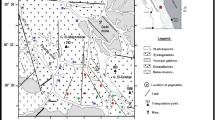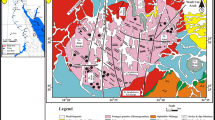Abstract
To understand trace radionuclide (uranium) migration occurring in rocks, a granitic batholith located at the Korea Atomic Energy Research Institute (KAERI) site was selected and investigated. The rock samples obtained from this site were examined using mineralogical methods, including scanning electron microscopy (SEM) and electron probe microanalysis (EPMA). The changes in the distribution pattern of uranium (U) and small amounts of trace elements, and the mineralogical textures affected by weathering, were examined. Based on the element distribution analyses, it was found that Fe2+ released from fresh biotite is oxidized in short geological time, forming amorphous iron oxides, such as ferrihydrite, around silicate minerals. In that case, the amorphous ferrihydrite does not show distinct adsorption for U. However, as it gradually crystallizes to goethite or hematite, the most U-rich phases were found to be associated with the secondary iron oxides having granular forms. This evidence suggests that the geological subsurface environment is favorable for the crystallized iron oxides to keep their structures more stable for a long time as compared with the amorphous phases. There is a possibility that the long residence of U which is in contact with the stable crystalline phases of iron may finally lead to the partial sequestration of U in their structure. Consequently, it seems that Fe-oxide crystallization can be a dominating mechanism for U uptake and controls long-term U transport in granites with low U contents.






Similar content being viewed by others
References
Bargar, J. R., Reitmeyer, R., Lenhart, J. J., & Davis, J. A. (2000). Characterization of U(VI)-carbonato ternary complexes on hematite: EXAFS and electrophoretic mobility measurements. Geochimica et Cosmochimica Acta, 64, 2737–2749. doi:10.1016/S0016-7037(00)00398-7.
Bea, F. (1999). Uranium. In C. P. Marshall & R. W. Fairbridge (Eds.), Encyclopedia of geochemistry (pp. 645–648). Dordrecht: Kluwer Academic.
Casas, I., Pablo, J. D., Pérez, I., Giménez, J., Duro, L., & Bruno, J. (2004). Evidence of uranium and associated trace element mobilization and retention processes at Oklo (Gabon), a naturally radioactive site. Environmental Science & Technology, 38, 3310–3315. doi:10.1021/es0353863.
Choo, C. O. (2002). Characteristics of uraniferous minerals in Daebo Granite and significance of mineral species. Journal of Mineralogical Society of Korea, 15, 11–21.
Coston, J. A., Fuller, C. C., & Davis, J. A. (1995). Pb2+ and Zn2+ adsorption by a natural aluminum- and iron-bearing surface coating on an aquifer sand. Geochimica et Cosmochimica Acta, 59, 3535–3547. doi:10.1016/0016-7037(95)00231-N.
Duff, M. C., Coughlin, J. U., & Hunter, D. B. (2002). Uranium coprecipitation with iron oxide minerals. Geochimica et Cosmochimica Acta, 66, 3533–3547. doi:10.1016/S0016-7037(02)00953-5.
Edghill, R. (1991). The redistribution of uranium with weathering in the Koongarra uranium deposit. Radiochimica Acta, 52(53), 381–386.
Faure, G. (1986). Principles of isotope geology. New York: Wiley.
Horie, K., Hidaka, H., & Gauthier-Lafaye, F. (2006). Elemental distribution in zircon: Alteration and radiation-damage effects. Physics and Chemistry of the Earth, 31, 587–592.
Hunter, D. B., & Bertsch, P. M. (1998). In situ examination of uranium contaminated soil particles by micro-X-ray absorption and microfluorescence spectroscopies. Journal of Radioanalytical and Nuclear Chemistry, 234, 237–242. doi:10.1007/BF02389778.
Jang, J., Dempsey, B. A., & Burgos, W. D. (2007). A model-based evaluation of sorptive reactivities of hydrous ferric oxide and hematite for U(VI). Environmental Science & Technology, 41, 4305–4310. doi:10.1021/es070068f.
Jeong, G. Y., & Kim, H. B. (2003). Mineralogy, chemistry, and formation of oxidized biotite in the weathering profile of granitic rocks. The American Mineralogist, 88, 352–364.
Koons, R. D., Helmke, P. A., & Jackson, M. L. (1980). Association of trace elements with iron oxides during rock weathering. Soil Science Society of America Journal, 44, 155–159.
Koppi, A. J., Edis, R., Field, D. J., Geering, H. R., Klessa, D. A., & Cockayne, J. H. (1996). Rare earth element trends and cerium-uranium-manganese associations in weathered rock from Koongarra, Northern Territory, Australia. Geochimica et Cosmochimica Acta, 60, 1695–1707. doi:10.1016/0016-7037(96)00047-6.
Krauskopf, K. B. (1986). Thorium and rare earth metals as analogs for actinide elements. Chemical Geology, 55, 323–335. doi:10.1016/0009-2541(86)90033-1.
Lee, S. Y., Baik, M., Cho, W. J., & Hahn, P. (2006). Rock weathering and geochemical characteristics in the KURT. Journal of Korean Radioactive Waste Society, 4, 321–328.
Murakami, T., Ohnuki, T., Isobe, H., & Sato, T. (1997). Mobility of uranium during weathering. The American Mineralogist, 82, 888–899.
Nesbitt, H. W. (1979). Mobility and fractionation of rare earth elements during weathering of a granodiorite. Nature, 279, 206–210. doi:10.1038/279206a0.
Noseck, U., Brasser, T., Rajlich, P., Laciok, A., & Hercik, M. (2004). Mobility of uranium in tertiary argillaceous sediments—a natural analogue study. Radiochimica Acta, 92, 797–803. doi:10.1524/ract.92.9.797.54972.
Ohnuki, T., Isobe, H., Yanase, N., Nagano, T., Sakamoto, Y., & Sekine, K. (1997). Change in sorption characteristics of uranium during crystallization of amorphous iron minerals. Journal of Nuclear Science and Technology, 34, 1153–1158. doi:10.3327/jnst.34.1153.
Payne, T. E., & Airey, P. L. (2006). Radionuclide migration at the Koongarra uranium deposit, Northern Australia—lessons from the Alligator Rivers analogue project. Physics and Chemistry of the Earth, 31, 572–586.
Sato, T., Murakami, T., Yanase, N., Isobe, H., Payne, T. E., & Airey, P. L. (1997). Iron scavenging uranium from groundwater. Environmental Science & Technology, 31, 2854–2858. doi:10.1021/es970058m.
Schwertmann, U., & Cornell, R. M. (2000). Iron oxides in the laboratory. Germany: Wiley-VCH.
Stubbs, J. E., Elbert, D. C., Veblen, D. R., & Zhu, C. (2006). Electron microbeam investigation of uranium-contaminated soils from Oak Ridge, TN, USA. Environmental Science & Technology, 40, 2108–2113. doi:10.1021/es0518676.
Taboada, T., Cortizas, A. M., García, C., & García-Rodeja, E. (2006). Uranium and thorium in weathering and pedogenetic profiles developed on granitic rocks from NW Spain. The Science of the Total Environment, 356, 192–206. doi:10.1016/j.scitotenv.2005.03.030.
Waite, T. D., Davis, J. A., Payne, T. E., Waychunas, G. A., & Xu, N. (1994). Uranium(VI) adsorption to ferrihydrite: Application of a surface complexation model. Geochimica et Cosmochimica Acta, 58, 5465–5478. doi:10.1016/0016-7037(94)90243-7.
Author information
Authors and Affiliations
Corresponding author
Rights and permissions
About this article
Cite this article
Lee, S.Y., Baik, M.H. Uranium and other trace elements’ distribution in Korean granite: implications for the influence of iron oxides on uranium migration. Environ Geochem Health 31, 413–420 (2009). https://doi.org/10.1007/s10653-008-9194-5
Received:
Accepted:
Published:
Issue Date:
DOI: https://doi.org/10.1007/s10653-008-9194-5




